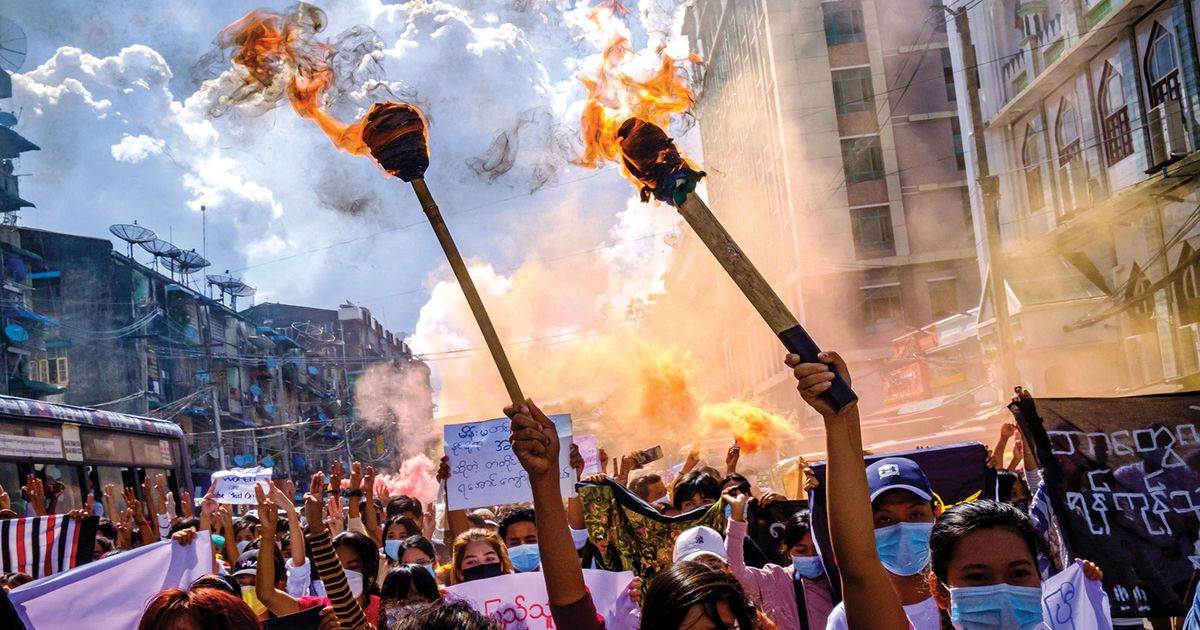
The image of five Myanmar teens leaping off an apartment building to evade capture by soldiers on 11 August (two of them died) has come to symbolise the popular sentiment six months into the military dictatorship of the Tatmadaw, which seized power on 1 February after a landslide loss in national elections.
Artists are among those hit hard this summer, as violence by the Tatmadaw is compounded by one of the world’s worst Covid-19 outbreaks and a stalled economy worsening food insecurity. The July flooding of Myanmar’s rural areas and Rohingya refugee camps in Bangladesh has further impacted tens of thousands. “Everyone is struggling to survive financially and emotionally, and in particular trying to keep themselves and their families safe from Covid,” says the artist Htein Lin.
“Many famous artists, writers, cartoonists, actors and musicians have died from Covid, particularly those over the age of 60,” Htein Lin says. “I think we have counted 117 already in the arts, 43 of them painters, but I am sure there are more. It is a great loss for us all. It reminds me of how intellectuals were all killed by the Khmer Rouge [Cambodia’s brutal regime from 1975-79] and they lost a generation.”
“Life in Myanmar generally right now is slow and grim,” says the artist Soe Yu Nwe, who, like Htein Lin, is based in Yangon. The “majority of businesses are closed, and most people are losing income. Some people are guessing there might be an economic depression or recession. The infection and fatality rates are definitely underreported.”
Artists who have fallen victim to July’s outbreak include Myint San Myint, who had joined Soe Yu Nwe and Htein Lin in a virtual exhibition at Hong Kong’s Karin Weber Gallery, organised by Melissa Carlson. Also lost were the trailblazing artists Sonny Nyein and Tin Maung Oo. Though subsiding by mid-August, the third wave peaked in late July at 7,083 confirmed infections and 396 deaths in one day, which per capita exceeds the worst of India’s spring surge.
Negligible vaccination rates and the military’s hoarding of medical supplies and international aid, as well as mass arrests of political protesters, have exacerbated the outbreak. Moe Satt, one of Myanmar’s most outspoken and internationally recognised artists, was detained between March and July, and has been posting new works exploring his experience on Instagram. Several illustrators and poets were also arrested, Htein Lin says, when after a few weeks “the military started laying 505a charges [making it a crime to make comments that could cause fear or spread false news] on many social influencers, including actors and musicians and artists, accusing them of using Facebook to encourage people to oppose the military government. Many of them went into hiding.”
Food shortages
The junta led by Min Aung Hlaing has killed at least 1,058 civilians since the coup, according to the Assistance Association for Political Prisoners and holds at least 5,630 in arbitrary detention. Fighting between the Tatmadaw and rebel groups, primarily the People’s Defense Force, has displaced 220,000 people, mostly in ethnic minority areas in the states of Shan, Chin and Kachin. The UN identifies two million more people as being in urgent need of humanitarian aid, largely in the urban centres of Yangon and Mandalay, while the World Food Programme estimates that people facing food shortages will climb to 6.2 million by October, up from 2.8 million prior to February. On 7 September, the shadow National Unity Government declared a war of resistance.
Soe Yu Nwe describes the situation as “visual and visceral”. She says that “there is no way to accurately collect data on Covid cases or predict when they will peak”, and most reliable local news sources have been blocked or closed by the government. “You hear and know from the ambulance sounds around you,” she says. “The reality here is very different to elsewhere.” Banks were closed in mid-August in order, some believe, to obstruct pro-democracy fundraising. “On the streets there are more military trucks, and they are bigger, too. They are on attack mode with their weapons pointing towards the front and back. It is quite unnerving driving behind them.”
The outbreak “has doubled down on our despondency,” Htein Lin says, slowing the Civil Disobedience Movement to a crawl. “People are focused on survival, and getting oxygen and medicine, and caring for their loved ones. But there are still small flash-mob demonstrations each day in Mandalay and some villages and rural towns.”
Myanmar’s art venues started closing soon after the coup. Soe Yu Nwe says: “It’s pretty quiet, and dangerous to do a good show now, since good art is relevant to the now and it is impossible to speak about the present in Myanmar without putting yourself in danger.” Artists are instead exhibiting online and abroad when possible, but shipping has been rendered difficult due to infrequent flights and closed offices and banks. Soe Yu Nwe will next show with Kuala Lumpur’s A+ Works of Art (22 October-20 November), while Htein Lin’s work is appearing this month at La Maison Sur La Sorgue in Provence, France.
“Most Myanmar artists have always struggled financially,” Htein Lin says, and an expatriate exodus since the coup has evaporated their collector base. “Obviously the 18% contraction in the economy has squeezed them further,” he adds. Overseas scholarships, residencies and fellowships have proven a lifeline for some, particularly this year. Prior to the coup, Htein Lin, along with Moe Satt, the New York-based artist Chaw Ei Thein and others, founded the Association of Myanmar Contemporary Art to advocate for cultural policy and arts teaching. The association has now morphed into a US-registered nonprofit aimed at building cultural ties in support of resistance in Myanmar. “We know we are not the only country where artists are struggling economically and politically, and we will demonstrate solidarity with others.”
Source link : https://www.theartnewspaper.com/news/myanmar-s-artists-face-destitution












